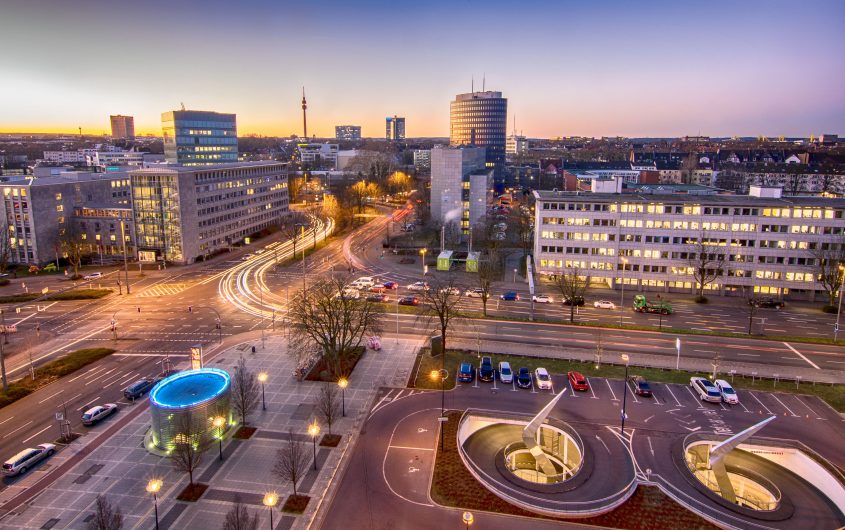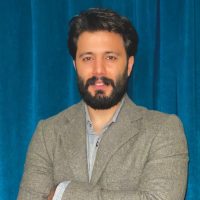
Roland Gorecki via Wikimedia Commons
Either-or? As-well-as?

Barış Şahin
University of Cologne
Barış Şahin studied social sciences and German language and literature at the University of Cologne. He complemented his studies with cultural and religious studies at the University of Education Weingarten and Bilgi University in Istanbul and is currently finishing his Master's degree in the Teachers Education Program at the University of Cologne. In his research and activist work, he focuses on the various transnational and transcultural discourses of identity, racism, and ideologies of inequality in German society. As a scholarship holder of the Rosa Luxemburg Foundation, alumnus of the German-American Fulbright Commission (The Ohio State University, Seminar on "Diversity and Inclusion in the Classroom"), and the DialoguePerspectives, a Leo Baeck Foundation program, he was able to contribute and expand his academic and political proficiency on an international level, with the aim of making a significant contribution to European understanding and cooperation, to strengthening and defending civil society, and to shaping a plural, democratic, antiracist and solidary Europe. The experiences Mr. Şahin has gained in the course of his engagement and work have made him an expert of a new, society-oriented intercultural-worldview dialogue. He is active as a speaker, interlocutor, and advisor to civil society organizations and NGOs engaged in shaping a plural society. As head of various state and federal projects funded by the German Federal Ministry for Family Affairs, Senior Citizens, Women and Youth and the Ministry for Children, Family, Refugees and Integration of North Rhine-Westphalia, he has helped shape new social discourses, such as on the topic of identity formation among adolescents with a migration background in Germany.

Philippa Hughes
CuriosityConnects.us
Philippa P.B. Hughes is a social sculptor and creative strategist who produces creative projects that transform society through humanizing and compassionate conversations between people who might not normally meet. She has designed and produced hundreds of unconventional, delightful, and fun activations aimed at building social capital, social cohesion, and social discourse. Her practice prioritizes relationships and encompasses a multi-disciplinary approach that is informed by sociology, psychology, philosophy, political science, community organizing, design thinking, art, and humanities. She leads CuriosityConnects.us, a partner in Looking For America, a national series inviting politically diverse guests to break bread and talk to each other face-to-face.
The logic of hybrid identities and the attempt to break through borders
In his last speech as president, Ronald Reagan said, “You can go to France and live there, but you cannot become a Frenchman. You can go to Germany or Turkey or Japan, but you can’t become a German or a Turk or a Japanese. But anybody, from any corner of the earth, can come to America and become an American.”
By participating in the AGI program “Social Divisions and Questions of Identity in Germany and the United States,” we could see a direct link to Reagan’s words. In the course of the program, the question of one’s own identity in an ever-changing society and environment was raised again and again and ultimately formed the starting point for this article. We kept asking ourselves, “What is identity? What are hybrid identities?” This essay also reflects the hybridity of the authors. An interplay of academic research and autobiographical textual processing are intended to give readers a sense of the complexity of the topic, the contradictions of social coexistence, as well as the importance of this AGI program.
Each participant brought a different perspective to the conversation. A climate activist and community organizer working toward an automobile-free society. An economist whose research centers on the social and political implications of economic change. An academic who focuses his research on public policy and atrocity prevention. We scratched the surface in multiple meetings and presentations on broad ideas throughout our week in Dortmund. However, it was in the side conversations during meals and while walking between meetings where we dug deeper into the implications of these ideas on society and on our personal realities.
Philippa Pham Hughes
I kept going back to a week-long conversation with Barış Şahin, a “hybrid” like me, who also grapples with his multi-racial identity, both of us living in places that have told us we don’t belong. I am the daughter of a Vietnamese immigrant who came to the United States in 1975 and a descendant of Irish and English immigrants to the United States in the mid-19th century. I recently discovered my biological father, who was the son of Eastern European Jewish parents who came to the United States at the end of the 1800s.
Barış’ family is of Alevi-Kurdish origin and thus belongs to an ethnic and religious minority community in Turkey. Due to the oppression by the Turkish state, the widespread discrimination and reprisals by the Sunni-Turkish dominant culture and the majority society, they kept their religious and ethnic affiliation hidden as far as possible. In the eighties, his family had considerable problems in this regard. In this sense, Barış’ father decided to flee from Turkey via France to the Federal Republic of Germany due to oppression. There, he longed to live in a state that respected the principles of religious and political freedom. Barış now belongs to the second generation of his family in Germany and therefore understands the difficulties and problems that young people from different cultural, ethnic, and religious backgrounds face at school, during college, or even in everyday life.
The demographics in each of our countries is changing rapidly, though, and our bodies are at the forefront of this change. This change is at the root of polarization and social divisions that threaten to tear apart the fabric of liberal democracy. For many, demographic change feels like a threat. Over half of the January 6 insurrectionists came from counties that saw significant declines in the non-Hispanic White population, and 95 percent of the insurrectionists were White. Sarah Palin once told a group of White people in a small town that they were the “real Americans.” Donald Trump rose to political power by telling people he would make America great again by taking our country back to a time before power began to redistribute away from complete White dominance.
Demographic change is an inevitability, though. In the United States, demographic trends indicate that White Americans will become the minority by 2045. Immigration and increasing multiracial populations–hybrids–will lead the growth of non-Hispanic White population growth in the United States. In Germany, the population is stagnating as net immigration increases. What do these statistics mean when we ask what it means to be American or to be German? Hyphenated identities that are grounded in bi-racial narratives no longer make sense under these circumstances.
To become American once meant to meld into a great Melting Pot, to speak English, to recite the pledge of allegiance that ignored non-White stories, to love apple pie and baseball. Assimilation meant erasing whatever heritage and culture your family brought from wherever they came and meld into a monoculture based mostly on its Northern European roots. Today in the United States, American culture has adopted more and more from all its immigrants. People seek out pho, and salsa is the most popular condiment in America. I rarely see a hyphenated American identity anymore because that hyphen cannot adequately describe these mixed identities.
Regardless of how culturally “American” I become, though, and even though I don’t speak an Asian language, I am still asked, “Where are you really from?” As long as I have an Asian face, I will be considered an “other” and made to feel I don’t fully belong in this country.
Barış Şahin
But what actually is hybridity? The concept of hybridity underwent a shift in meaning over the last centuries. Even before the concept of hybridity was a racist notion and later became accepted as a negatively-connoted counterpart to the expression of purity, concepts of biology and botany were associated with hybridity in the nineteenth century. For the crossing between two species in the plant or animal world are still called hybrids today in a value-neutral way.[1]
In order to apply this hybrid conceptualization to human beings, a race-theoretical classification of humanity was required. Colonial discourse in the nineteenth century established two theses about the human family, monogenesis and polygenesis. Proponents of polygenesis (different human species) used the analogy to the mule and made a direct connection between infertility and hybrid humans. They wanted to prove that humans exhibit species-specific attributes and used these arguments to justify a division of human races with different values. After reproduction between races throughout European colonies disproved this, theorists directed polygenesis to another focus of hybridity: hybrids had to be human degenerations. In order to not compare or even equate the hybridization in a colony with the mixing of European peoples, these polygenesis theorists characterized a hybrid human being, coming from a “union between nearby races, as for example in Europe,” with development and fertility, whereas “the crossing between distant races […] had to lead to degeneration.”[2]
In the course of the ongoing debate around hybridity, the term was detached from its racist context and introduced into a newer—as well as more current—context. In the meantime, the discourse has continued on the basis of the concept of culture. This means that concepts such as race and culture act as dynamic variables of the discourse of hybridity, becoming blurred and contextualized in certain ways. “Nonetheless, hybridity continues to be associated with bastardization and impurity in some contexts.”[3]
Hybridity is also taken up by the decolonial writer Homi K. Bhabha. In his book The Location of Culture, he deals in particular with the concept of the “Third Space,” which enables the encounter of diversity. He argues that this is not an existing physical space, but rather a possible venue for differences. Bhabha further postulates that the Third Space is a place of discourse. It arises whenever people from different cultures meet to discuss meaning and content. Accordingly, the Third Space is a hybrid place and promotes constant discussion about cultural difference.[4]
With this concept, Bhabha articulates a hybrid venue for cultural difference. This leads him to assume that cultures are fundamentally always hybrid and uses hybridity as a contrast to cultural essentialism.[5] He assumes that cultures are not uniform and homogeneous, but heterogeneous and diverse. According to this thought, cultures are neither static nor entrenched systems: they are dynamic and open. Consequently, hybrid culture in Bhabha’s view is permeated by ambivalence, since any attempt to explain and represent a culture results in a lack of continuity. Thus, there is a need for a constant renegotiation of the concept of culture, which takes place in the Third Space.
Hybridity is not only articulated in the context of hybrid cultures but is equally addressed in the discourse on hybrid identities. Hein illuminates that the “hybridization of culture and the formation of hybrid cultural identities takes place predominantly in the context of migration and diaspora.”[6]
Belonging to certain social or cultural contexts can manifest itself in a flagrant or even diffuse manner. This means that affiliation groups can vary in size. Thus, communities the size of a neighborhood are comprehensible, whereas in some cases one has to assume an imagined community, since a causal connection between the individual and the community is hardly apparent. Hein is referring to the collective of the nation, where it is not true “that the participants get to know each other in their entirety.”[7] Since an individual is tied to a conglomerate of affiliations, cultural identity is always permeated by heterogeneity. In this regard, it is merely the interest and context of the individual that ultimately determines which affiliations receive priority.
In the context of different affiliations, hybrid identity therefore proves to be a strategic negotiation of cultural differences. Hein therefore defines hybridity in terms of cultural identities as follows:
Finally, the category of the hybrid is also discussed in relation to cultural identities. Here, the term hybrid identities refers to the experience between cultures. Hybrid identities refer to identities that emerge in the confrontation, connection, and intersection of different cultural contexts. Hybrid identities are cultural identities in transition.[8]
These identities in transition are not bound by the borders and interests of a particular culture or nation. They bundle different characteristics, contexts, cultures, or experiences as partial identities in their person and oppose the “either-or” in favor of the “as-well-as” logic.
Hybridity in Dortmund
Dortmund offered us this Third Space in which we continued to examine and negotiate the meaning of hybridity. We brought our personal hybrid experiences to the conversations that took place throughout the program with our fellow participants and with our hosts throughout the city. In this sense, the discourse represented Bhabha’s Third Space. Dortmund also offered discourse in physical spaces that encouraged us to think about hybridity in the context of public policy. At lokal wilkommen, we saw firsthand the ways in which public-private partnerships can come together to provide services that ease the transition for refugees. This organization encourages established residents to participate in welcoming newcomers, thus contributing to the creation of a hybrid community.
At Tatis Cafe, we experienced a space in which humanizing interactions took place over food that reflected the fusion of cultures while maintaining respect for cultural diversity. Culture is not static, and hybridity is a dynamic state that requires constant renegotiation. Food and hospitality open up more space for these necessary conversations.
[1] Kerstin Hein, Hybride Identitäten: Bastelbiografien im Spannungsverhältnis zwischen Lateinamerika und Europa (Bielefeld, 2006), p. 54.
Naika Foroutan, “Hybrid Identities: Normalization, Conflict Factor and Resource in Postmigrant Societies,” in Dabeisein und Dazugehören: Integration in Deutschland, ed. Heinz Ulrich Brinkmann, Haci-Halil Uslucan (Wiesbaden: Springer VS, 2013), 85–99, p. 90.
[2] Hein, p. 54.
[3] Hein, p. 55.
[4] Homi K. Bhabha, The Location of Culture Routledge (New York: Routledge, 1994), p. 36-38
[5] Cinur Ghaderi, Politische Identität-Ethnizität-Geschlecht: Selbstverortungen politisch aktiver MigrantInnen (Wiesbaden: Springer VS, 2014) p. 87-88.
[6] Hein, p. 60.
[7] Ibid.
[8] Hein, p. 433.
Further readings:
Anzaldúa, Gloria. Borderlands/La Frontera: The New Mestiza (San Fransisco: Aunt Lute Books, 1987).
Crenshaw, Kimberle. “Demarginalizing the Intersection of Race and Sex: A Black Feminist Critique of Antidiscrimination Doctrine, Feminist Theory and Antiracist Politics.” University of Chicago Legal Forum 1989, no. 1, Article 8.
Hall, Stuart. Rassismus und kulturelle Identität: Ausgewählte Schriften 2 (Hamburg: Argument Verlag, 2018).









